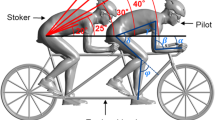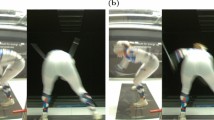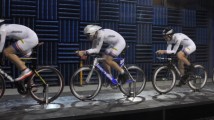Abstract
The speed attained by a track cyclist is strongly influenced by aerodynamic drag, being the major retarding force in track events of more than 200 m. The aims of this study were to determine the effect of changes in shoulder and torso angles on the aerodynamic drag and power output of a track cyclist. The drag of three competitive track cyclists was measured in a wind tunnel at 40 kph. Changes in shoulder and torso angles were made using a custom adjustable handlebar setup. The power output was measured for each position using an SRM Power Meter. The power required by each athlete to maintain a specific speed in each position was calculated, which enabled the surplus power in each position to be determined. The results showed that torso angle influenced the drag area and shoulder angle influenced the power output, and that a low torso angle and middle shoulder angle optimised the surplus power. However, the lowest possible torso angle was not always the best position. Although differences between individual riders was seen, there was a strong correlation between torso angle and drag area.











Similar content being viewed by others
References
Oggiano L, Leirdal S, Saetran L, Ettema G (2007) Aerodynamic optimization and energy saving of cycling postures for international elite level cyclists. In: The Engineering of Sport 7, vol 1. Springer, Paris, pp 597–604
Martin JC, Milliken DL, Cobb JE, McFadden KL, Coggan AR (1998) Validation of a mathematical model for road cycling power. J Appl Biomech 14:276–291
Zdravkovich MM, Ashcroft MW, Chisholm SJ, Hicks N (1996) Effect of cyclist’s posture and vicinity of another cyclist on aerodynamic drag. In: Haake SJ (ed) 1st International Conference on the Engineering of Sport. A.A. Balkema, Sheffield, pp 21–28
Grappe F, Candau R, Belli A, Rouillon JD (1997) Aerodynamic drag in field cycling with special reference to the Obree’s position. Ergonomics 40(12):1299–1311
García-López J, Rodríguez-Marroyo JA, Juneau C-E, Peleteiro J, Martínez AC, Villa JG (2007) Reference values and improvement of aerodynamic drag in professional cyclists. J Sports Sci 26(3):277–286
Kyle CR (2003) Selecting cycling equipment. In: Burke ER (ed) High-tech cycling, 2nd edn. Human Kinetics, Champaign, pp 1–48
Burke ER, Pruitt AL (2003) Body positioning for cycling. In: Burke ER (ed) High-tech cycling, 2nd edn. Human Kinetics, Champaign, pp 69–92
Lukes RA, Chin SB, Haake SJ (2005) The understanding and development of cycling aerodynamics. Sports Eng 8:59–74
Oggiano L, Leirdal S, Sætran L, Ettema G (2008) Aerodynamic optimization and energy saving of cycling postures for international elite level cyclists. In: The engineering of sport 7, vol 1. Springer, Paris, pp 597–604
Savelberg H, Van de Port IGL, Willems PJB (2003) Body configuration in cycling affects muscle recruitment and movement pattern. J Appl Biomech 19:310–324
Too D, Landwer GE (2004) The biomechanics of force and power production in human powered vehicles. Hum Power 55:3–6
Wilson DG (2004) Bicycling science, 3rd edn. The MIT Press, London, p 215
Acknowledgments
J. Schumacher would like to thank the German Academic Exchange Service, L. Underwood would like to thank the University of Canterbury for sponsorship and the opportunity to carry out this study, and all authors would like to thank Graeme Harris, the wind tunnel technician, and all the athletes who gave up their time to take part in this study.
Author information
Authors and Affiliations
Corresponding author
Appendix 1
Appendix 1
Subject 1
Height: 173 cm
Mass: 65 kg
BMI: 21.7
Age: 16 years
Event: Road cycling, track 3–4 km
Years in discipline: 2.5 years
Subject 2
Height: 178 cm
Mass: 74 kg
BMI: 23.4
Age: 27 years
Event: Road criterium 30–100 km, track endurance 15–50 km
Years in discipline: 9 years
No aero helmet—road helmet worn for all tests
Subject 3
Height: 177 cm
Mass: 76 kg
BMI: 25
Age: 45 years
Event: Road cycling, time trial 25–40 km
Years in discipline: 20 years.
Rights and permissions
About this article
Cite this article
Underwood, L., Schumacher, J., Burette-Pommay, J. et al. Aerodynamic drag and biomechanical power of a track cyclist as a function of shoulder and torso angles. Sports Eng 14, 147–154 (2011). https://doi.org/10.1007/s12283-011-0078-z
Published:
Issue Date:
DOI: https://doi.org/10.1007/s12283-011-0078-z




